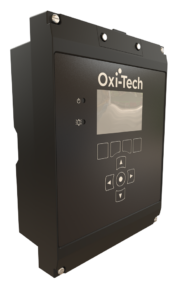Defra and Innovate UK recognise potential of chemical-free disinfection in dairy parlours
20th December 2021
A grant is available for award-winning ozone disinfection technology that promises to offer a safer, more effective and more environmentally friendly solution – with benefits for milk quality, mastitis rates and money-saving.
A few years ago, it would have been hard to envision a dairy parlour where cows decided when they wanted to be milked, and a robot provided the solution. Now, the possibility of having a self-generating supply of disinfectant for your dairy parlour, without the need to buy, handle and dispatch blue-barrel disinfectants is also a reality.
Oxi-Tech Solutions’ award-winning disinfection technology has come to the attention of Defra and is available for dairy farmers with a £15,000 grant towards your system if you apply before Jan 7th 2020 (click here to apply). It’s a golden opportunity to install a powerful, environmentally safe, low carbon disinfection system in your parlour, Oxi-Tech says.
What does it involve?
The process comprises a reactor vessel, fed with mains or borehole water from your farm, and reactor cells which convert some of the oxygen in the water into dissolved ozone; a powerful, clean disinfectant with a razor-sharp affinity for killing bacteria, viruses and protozoa.
Whenever your dairy parlour calls for a disinfection flush for the system, or for the milking clusters, ozonated water is called into action and provides a safer, more effective, and much more environmentally friendly means of disinfection than hypochlorite or peracetic acid (PAA), Oxi-Tech explains.
In the modern dairy parlour, monitoring processes remotely can be important too. The Oxi-Tech process operates via a small control unit, which communicates with your milking process. The controller called the Oxi-Hub, can be monitored directly or from your computer or mobile smartphone, and will show you how the system is performing. It will also save data over months of operation, so your customers can see your disinfection records. You can even change the settings in the process remotely should the need arise.
In addition to Defra’s inclusion of the technology under FETF84 for conventional milking parlours, Innovate UK has recognised the potential of the Oxi-Tech process in robotic dairies, and is funding a 12-month project to document its effectiveness in robot disinfection in conjunction with the Agri-EPI Centre.
So why change?
As the new process uses only water and small amounts of electricity, it does away with the cost and environmental damage caused by bulk chemical disinfectants.
“Oxi-Tech typically provides a 12–18-month payback to dairy farmers,” says Luke Rutterford, Oxi-Tech’s technical director. “A demonstration of the technology over the last two years on a herd of 200+ shorthorn milkers has shown that, day after day, the process has delivered better quality milk (lower Bactoscan levels) and lower rates of mastitis than with the old hypochlorite and PAA process.”
The farm’s herd manager Andrew adds: “There’s no manual handling of 200-litre drums of chemical, nor health and safety issues concerning chemical burns. It’s made my life a lot easier, and a lot safer”.
So, typical savings for a herd of approximately 200 cows could amount to more than £2,000 a year on chemicals, between £211 and £1,148 for each cow staying free of mastitis (AHDB DMCP calculator), and a few pence on each litre of milk by maintaining quality in the top bracket. Add to that the health, safety and environmental benefits, and the reason to change seems a lot simpler.
Dairy farmers are leading the way in the new wave of agricultural technology, as they align themselves with the sustainability and productivity expectations of the modern farm. Greening cleaning processes seem like a good area on which to focus. Assured biosecurity in your dairy parlour not only reduces cow-to-cow infections and yields high quality milk, both of which boost productivity and profitability – but the Oxi-Tech process moves your farm closer to Net Zero, the company says.
A game changer
You might ask why ozone hasn’t become popular in this application before. “Our process produces ozone in solution when and where it’s needed,” explains Luke Rutterford. “It’s a completely new way of producing this powerful form of oxygen, and so much easier and cheaper than producing it as a gas from air or oxygen. We think it’s a game-changer.”
Ozone is commonly used to treat drinking water in the UK, and is proven to be one of the most effective ways to eradicate biofilms, which means it kills microorganisms at low doses over short contact times. Compared with chlorine it is both more powerful and leaves no harmful by-products, and will kill some pathogens which chlorine will not, like Cryptosporidium.
This makes it attractive as an animal drinking water disinfectant on farms using borehole water or rainfall catchment. Once ozone has undertaken disinfection, any remaining simply reverts to oxygen, providing disinfection without leaving residues (such as chlorate) in the water, the milk, the equipment or the environment.
Cleaner milk, a healthier herd and a safer, greener farming environment, and a more profitable dairy business to boot.


